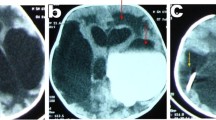Abstract
Background
Intraventricular haemorrhage is the most common cause of hydrocephalus in a pre-term baby and may require surgical intervention depending on severity.
Clinical case
This case illustrates foraminal septae as a subtle cause of progressive quadriventricular hydrocephalus in a child born pre-term with a history of grade III intraventricular haemorrhage. The septae within the fourth ventricular exits were clearly demonstrated with 3D-FIESTA (fast imaging employing steady-state acquisition) MRI acquisitions and assisted in differentiation from communicating hydrocephalus. This finding guided the decision to a successful endoscopic third ventriculostomy.
Conclusion
3D-FIESTA sequence is recommended for investigating children with hydrocephalus secondary to intraventricular haemorrhage due to its diagnostic potential and implications on surgical technique.




Similar content being viewed by others
References
Fernell E, Hagberg G, Hagberg B (1994) Infantile hydrocephalus epidemiology: an indicator of enhanced survival. Arch Dis Child-Fetal Neonatal Ed 70(2):F123–F128
Tsitouras V, Sgouros S (2011) Infantile posthemorrhagic hydrocephalus. Child’s Nerv Syst 27(10):1595–1608
Murphy B, Inder T, Rooks V, Taylor G, Anderson N, Mogridge N, Horwood L, Volpe J (2002) Posthaemorrhagic ventricular dilatation in the premature infant: natural history and predictors of outcome. Arch Dis Child Fetal Neonatal Ed 87(1):F37–F41
Whitelaw A (1997) We need a new understanding of the reabsorption of cerebrospinal fluid. Acta Paediatr 86(2):133–134
Dinçer A, Kohan S, Özek M (2009) Is all “communicating” hydrocephalus really communicating? Prospective study on the value of 3D-constructive interference in steady state sequence at 3 T. Am J Neuroradiol 30(10):1898–1906
Muszinski C (2010) Posthemorrhagic hydrocephalus. Cerebrospinal fluid disorders Informa Healthcare USA, Inc, New York, pp 141–153
Aleman J, Jokura H, Higano S, Akabane A, Shirane R, Yoshimoto T (2001) Value of constructive interference in steady-state, three-dimensional, Fourier transformation magnetic resonance imaging for the neuroendoscopic treatment of hydrocephalus and intracranial cysts. Neurosurgery 48(6):1291
Ramli N, Cooper A, Jaspan T (2001) High resolution CISS imaging of the spine. Br J Radiol 74(885):862–873
Chavhan GB, Babyn PS, Jankharia BG, Cheng HLM, Shroff MM (2008) Steady-state MR imaging sequences: physics, classification, and clinical applications1. Radiographics 28(4):1147–1160
Everton K, Rassner U, Osborn A, Harnsberger H (2008) The oculomotor cistern: anatomy and high-resolution imaging. Am J Neuroradiol 29(7):1344–1348
Seitz J, Held P, Strotzer M, Völk M, Nitz W, Dorenbeck U, Stamato S, Feuerbach S (2002) MR imaging of cranial nerve lesions using six different high–resolution T1–and T2(*)–weighted 3D and 2D sequences. Acta Radiologica 43(4):349–353
Yagi A, Sato N, Taketomi A, Nakajima T, Morita H, Koyama Y, Aoki J, Endo K (2005) Normal cranial nerves in the cavernous sinuses: contrast-enhanced three-dimensional constructive interference in the steady state MR imaging. Am J Neuroradiol 26(4):946–950
Buxton N, Turner B, Ramli N, Vloeberghs M (2002) Changes in third ventricular size with neuroendoscopic third ventriculostomy: a blinded study. J Neurol Neurosurg Psychiatry 72(3):385–387
Kurihara N, Takahashi S, Tamura H, Higano S, Furuta S, Jokura H, Umetsu A (2000) Investigation of hydrocephalus with three-dimensional constructive interference in steady state MRI. Neuroradiology 42(9):634–638
Laitt R, Mallucci C, Jaspan T, McConachie N, Vloeberghs M, Punt J (1999) Constructive interference in steady-state 3D Fourier-transform MRI in the management of hydrocephalus and third ventriculostomy. Neuroradiology 41(2):117–123
van Lindert EJ, Beems T, Grotenhuis JA (2006) The role of different imaging modalities: is MRI a conditio sine qua non for ETV? Child’s Nerv Syst 22(12):1529–1536
Javadpour M, Mallucci C, Brodbelt A, Golash A, May P (2001) The impact of endoscopic third ventriculostomy on the management of newly diagnosed hydrocephalus in infants. Pediatr Neurosurg 35(3):131–135
Fukuhara T, Vorster SJ, Luciano MG (2000) Risk factors for failure of endoscopic third ventriculostomy for obstructive hydrocephalus. Neurosurgery 46(5):1100
Acknowledgment
The authors gratefully acknowledge support from University Malaya Research Grant (RG178/09HTM).
Author information
Authors and Affiliations
Corresponding author
Rights and permissions
About this article
Cite this article
Fadzli, F., Ramli, N.M., Rahmat, K. et al. Neonatal post-hemorrhagic hydrocephalus resulting in foraminal septae—radiological technique and surgical implications. Childs Nerv Syst 29, 159–162 (2013). https://doi.org/10.1007/s00381-012-1923-5
Received:
Accepted:
Published:
Issue Date:
DOI: https://doi.org/10.1007/s00381-012-1923-5




